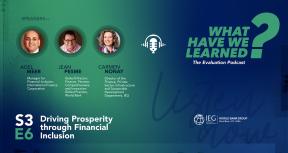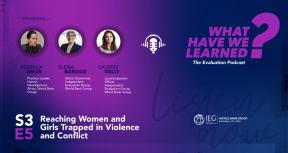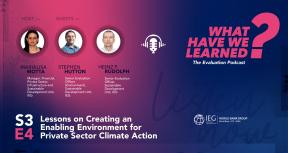Disasters caused by natural hazards increasingly threaten the lives and livelihoods of the world’s poor. Climate change is exacerbating the severity and impact of disasters by contributing to more destructive droughts, floods, and storms.
In this episode, we will explore how a more severe risk environment has been reshaping the way the World Bank and its partners approach disaster risk reduction. We will discuss the cost-effectiveness of disaster risk reduction investments, when and how can disaster risk reduction efforts be implemented, and why they are such a key component of adapting to climate change.
Our host, Carmen Nonay, will take listeners through a fascinating discussion held during the recent IMF-World Bank Annual meetings with experts working at the forefront of disaster risk reduction efforts. Carmen will highlight and comment on interventions by Mozambique’s Minister of Finance, Ernesto Tonela, Japan’s Deputy Vice Minister for International Affairs at Japan’s Ministry of Finance, Kentaro Ogata, Norway’s Minister of International Development, Anne Tvinnereim; and the president and CEO of the Bezos Earth Fund, Andrew Steer.
We will also hear from IEG’s Director General, Alison Evans, and Bernice Van Bronkhorst, the World Bank’s Global Director of the Urban, Disaster Risk Management, Resilience, and Land Global Practice.
Listen on Spotify, or Apple Podcasts.
Related Resources
Read the transcript
Minister Ernesto Tonela
Mozambique is one of the countries that least contributes to climate change, however, it's among the most exposed to natural hazards: the increase in frequency and magnitude of cyclones and floods that hit Mozambique resulting in the loss of numerous lives and painful damage to public and private infrastructure, also causing a food security disruption.
Deputy Vice Minister Kentaro Ogata
We know the heartache of losing everything to disasters. We have ingrained in our culture, the importance of building resilience to calamities. So if our experience could be useful to others, we will be happy to and very eager to share our expertise.
Carmen Nonay
You just heard Mozambique's Minister of Finance, Ernesto Tonela, and Japan's Deputy Vice Minister for International Affairs at Japan's Ministry of Finance, Kentaro Ogata. Both bear witness to the devastating impact that disasters caused by natural hazards have had on their respective countries.
Hello, and welcome to What Have We Learned? the evaluation podcast. My name is Carmen Nonay, I'm the Director of the Independent Evaluation Group's Finance, Private Sector, Infrastructure, and Sustainable Development Department, and I will be your host. Today, we will discuss the growing threat of disasters caused by natural hazards and what we have learned about building up resilience to them to reduce the risk of the damages they cause.
The floods in Pakistan, the extended heat waves and drought that have fueled wildfires across regions, and the above average hurricane season battering the Atlantic, are just some of the severe weather events we have seen recently. We are witnessing how climate change is amplifying the severity and impact of disasters by contributing to more destructive droughts, floods and storms. Disasters caused by natural hazards increasingly threaten the lives and livelihoods of the world's poor and disaster vulnerable populations. In fact, 82% of deaths caused by natural hazards and extreme weather occur in low and lower-middle-income countries.
In this episode, we will explore how a more severe risk environment has been reshaping the way the World Bank and its partners approach disaster risk reduction. We will discuss the cost effectiveness of Disaster Risk Reduction investments, when and how can disaster risk reduction efforts be implemented, and why disaster risk reduction is such a key component of adapting to climate change. To do this, I will be taking you through a fascinating discussion on this topic that I had the pleasure of moderating during the recent World Bank and International Monetary Fund Annual meetings. In addition to minister Tonela from Mozambique and Deputy Vice Minister Ogata from Japan, we had the privilege of hosting Norway's Minister of International Development, Anne Tvinnereimn, and the President and CEO of the Bezos Earth Fund, Andrew Steer. We will also hear from our Director General in IEG, Alison Evans, and our co-host for this event, Bernice van Bronkhorst, the World Bank's Global Director of the Urban, Disaster Risk Management, Resilience, and Land Global Practice.
Let's start with Andrew Steer and his take on how the practices and thinking around disaster risk reduction have evolved over the years.
Andrew Steer
The Bank is part of a major shift in the way we think about these issues. I was living in Jakarta as the World Bank Country Director on the 26th of December 2004 when the tsunami hit and more than 200,000 lives were lost. I went up there more than 30 times in the next 18 months. I think we responded as well as we possibly could. But to be absolutely honest, there wasn't the expertise that we could call upon. We simply didn't have the professionalism to respond, and this was just a response, let alone build back better, so to speak. I think we did a good job that actually led to all kinds of progress, but it's a different world now. It's a different world in two senses: one, the capacity that organizations like the World Bank and some of the other organizations have is just much richer. Second, the problem is much greater. We won't necessarily have more tsunamis, but we certainly will have more extreme weather events. And science can now tell us that if the water is warmer, if the air is warmer, more water will be absorbed and winds will be stronger. The Secretary General of the United Nations declared the hunger in southern Madagascar as the first truly demonstrated climate disaster that we've had. So what do we need to do? Well, what we can't do is keep going the way we've been going, we simply will not have the resources to keep responding.
Carmen Nonay
In fact, over the last decade, the World Bank has developed a large portfolio of both lending and analytical activities aimed at helping countries shift from post-disaster response to pre-disaster risk reduction. Here is Bernice van Bronkhorst speaking about the evolution of the World Bank's approach.
Bernice Van Bronkhorst
As Andrew pointed out, when he was Country Director in Indonesia in 2004 and the tsunami hit, the World Bank really didn't have the expertise to respond. We did reconstruction. It's in our name: IBRD, the International Bank for Reconstruction and Development. We forget that sometimes. We did a lot of reconstruction and didn't think much about disaster risk reduction, or indeed building back better. However, after learning from major disasters like the Indian Ocean tsunami, the Eastern Japan great earthquake and tsunami, multiple hurricanes, and many, many other disasters, we've really built up our expertise and started what we can honestly call a paradigm shift away from post-disaster reconstruction and humanitarian aid to ex-ante risk reduction. For example, we started considering how to make schools resilient. How to make our infrastructure resilient. How to prepare governments like the government of Mozambique to get ready both in terms of applying risk reduction measures to critical infrastructure, but also in terms of developing financial instruments. This includes disaster risk finance and insurance and coming up with new instruments that can really help countries deal with a crisis at the moment.
Carmen Nonay
This paradigm shift that Bernice mentioned has also been driven by increased access to science and technology. These advances continue to offer clarity as to what efforts contribute to the severity of natural hazards, and provide more tools to predict when a natural hazard will occur. Andrew Steer illustrated this point nicely in what he describes as different time horizons, and the level of accuracy with which it is now possible to anticipate natural hazards.
Andrew Steer
Over the last 10 years, the introduction, for example, of parametric disbursement techniques, has been a major breakthrough. But that was phase one. That says: when the wind reaches a speed of 100 kilometers an hour, we disperse money. That was an incredible breakthrough and the Bank was central in that system that is now fairly standard. We can do much better than that, though, and go one step further back because we now have the capacity to actually anticipate much more accurately. Think about three different time horizons. The first horizon covers how much we can anticipate an event such as a typhoon or hurricane. How much do we know about the event? When do we know it? We now know earlier and with much more detail. We're now seeing in countries like Bangladesh, astonishing disbursements of funds, even before the hurricane even arrives which can save 50% of the money and save 50% of the loss of lives. So we can now disperse funds and take action before something even happens. But then there's the next time horizon, the El Nino type thing, which covers two or three years. We now have the capacity of anticipating that with a lot more accuracy and get engaged much earlier on. Then the final time horizon we need to understand is the 10 to 30 years horizon, the real climate change effects. And what we can now do - through amazing big data, artificial intelligence, incredibly sophisticated models that could never be run even 10 years ago - is to do projections that are all probabilistic, of course, about which of the 15,000 river basins in the world will suffer the biggest impact and what will that impact look like? Now that has a lot of implications if you want to prepare because you can't afford necessarily to put money everywhere. You can't afford to invest in protection everywhere, but we ought to move towards a system where we can anticipate we are not doing that now almost at all.
Carmen Nonay
I want to bring Allison Evans in here with very interesting remarks on the cost-effectiveness of these Disaster Risk Reduction solutions as a powerful argument for scaling up investment in them. Allison pointed to evidence from IEG's recent evaluation of World Bank support for disaster risk reduction on the impact of these investments and how best to support them among a host of competing priorities.
Alison Evans
And the good news is that investments to reduce the risk of disaster from natural hazards do work and can deliver clear dividends for people and economies. Evidence confirms that investments in resilient infrastructure have a strong, positive net present value for every dollar invested. When countries rebuild infrastructure after disasters to be more resilient, it can reduce the impact of future disasters by as much as 30%. Yet, between 2010 and 2019, only around 4% of global Overseas Development Assistance (ODA) was linked to disaster work or toward prevention and preparedness for disasters coming from natural hazards. And this of course reflects, in part, the many competing priorities for ODA and the many competing priorities bearing down on already impossibly overstretched government budgets. So how can these priorities be reconciled in favor of urgent action for disaster risk reduction? And how can the case for scaling up the support be made and be made convincingly?
A recent evaluation undertaken by my group the Independent Evaluation Group of the World Bank Group examined a decade's worth of World Bank support for reducing disaster risks caused by natural hazards to inform the World Bank's scale-up of its support to climate change adaptation. And the evaluation finds that the World Bank has a strong track record of building the necessary evidence of risks on costs on benefits to influence the uptake of disaster risk reduction by borrowing countries. It also finds that disaster risk reduction is everyone's business, and that World Bank investments made better progress when focused on ministries of finance and critical line ministries rather than disaster agencies alone. The evaluation evidence also confirms the importance of sustained engagement, and finding the right entry points to move from an approach emphasizing response and reconstruction to one emphasizing mitigation and reduction of disaster risks for the longer term. The evaluation also finds evidence of the power of moving beyond isolated project interventions to put countries on a pathway towards more transformative change. And this requires doing the hard work of strengthening institutional capacities of designing and putting in place new policies and building a systemic approach, often using multiple instruments and interventions to building resilience across critical infrastructure and service delivery. This is no small agenda, but one that ultimately pays off in saved lives and more resilient climate-compatible livelihoods.
Carmen Nonay
Moving beyond isolated projects to pursue transformative change is something Mozambique has done very well and that is why having minister Tonela's voice was so important in the discussion, he described how the country has taken a comprehensive approach to this agenda with great results.
Ernesto Tonela, Mozambique’s Minister of Finance
One of the main challenges we have is the ability to adapt and recover from the multiple effects of natural disasters due to lack of resources. That's why, in our view, there is no other way to go rather than to step up climate change adaptation and build resilience. We are implementing a series of reforms aimed at improving our capacity to deal with prevention, build resilience and strengthten social and financial protection against the impact of climate change related disasters.
For example, our government first approved the National Adaptation and Climate Change Mitigation Strategy almost 10 years ago, and in line with the central framework for disaster risk reduction, the government adopted, in 2017, the Master Plan for Disaster Risk Reduction - the technical instrument that guides policies at all stages of the disaster cycle. In the same year, a Disaster Management Fund was created and includes, among the funds revenue scheme, an allocation of a percentage of the state budget as a contribution from the government as well as contributions from the private sector and cooperation donors. More recently, the financial protection component was improved with the strengthening of a legal framework and the approval of the Disaster Financial Protection plan in the course of 2022. Within this context, and with support from the World Bank, Mozambique has initiated the development of a financial protection agenda against disaster, which includes risk rotations and risk transfer mechanisms, such as such as insurance. In addition, we are further exploring opportunities related to contingency loans, which could allow us to rapidly trigger the release of credit in the aftermath of a disaster event.
Carmen Nonay
Mozambique's story is inspiring and serves as a model for weaving climate adaptation into policies and programs at multiple levels. The current global context is very complex, and governments are dealing with compounding crises on top of the lingering effects of the pandemic. In this context, it can be hard to identify the right moment to invest in disaster risk reduction, or even to see why it's a good investment. This is a very insightful exchange between Bernice and Andrew, on the economic case for disaster risk reduction and identifying entry points to deploy this effort.
Bernice Van Bronkhorst
There are hundreds of studies that show that every dollar invested in disaster risk prevention yields $6 to $10 in avoided losses. So again, the economic case is very clear. We also conduct these studies at the country level to really highlight why it makes sense for countries to invest their scarce resources in disaster risk reduction and prevention and avoid all these losses in the future. It's easier said than done because resources are scarce so there's always going to be that tension. What we have found, operationally, in this last decade is that when a natural disaster occurs, it's actually a great moment to start talking about longer-term adaptation and longer-term investment in risk reduction. That has often been where this agenda starts getting traction with governments. I think it's also critical to come back to what we've been saying: whatever we do as post-disaster response and reconstruction has to be building back better. We have to use the latest science, the latest information, and the latest modeling available in terms of risk exposure so that, when we build back better, we address not just today's risks, but also future climate risks.
Andrew Steer
I agree very much with Bernice that we need to convey the astonishing returns that come from this. And we need to simplify things. I mean, part of the problem is that we tend to make things too complicated. And a lot of ministers say I don't get it, I know how to do renewable energy, or I know how to do a jobs program. But, what is all this little bits and pieces of adaptation, it's all so complicated. And the adaptation community, and I take partly the blame for this, says that it's all very location specific, that you can't generalize. Well, then what can you do? So what I tell ministers are experiences like this. I moved to Hanoi in 1997 as a Country Director of the World Bank, and the first month we had a typhoon. 3,000 people died. Most of them fishermen who had no knowledge the weather was even coming and others in low-lying areas. Today, instead of killing 3000 people, they estimate that less than 10 would lose their lives. Why? Because now every fishing boat has a radio and tells you when things are coming. And the breakthrough was that there are no schools now in the low-lying areas that don't have to two floors. And by the way, they have ramps up so you can even take your goat and your donkey.
With Ngozi Okonjo-Iweala, when she was at the World Bank, we started the adaptation commission because we felt that there wasn't a narrative the way there was on mitigation, and there wasn't a link to the economy. And somebody in the press conference said to her: it's so complicated, what is it? And she said, but it's not really, I was in Bangladesh last month, and adaptation means you don't have chickens, you have ducks. Because it's going to flood so it's better to have animals that can swim.
More seriously, there is now an emerging set of information that can really inform this that we really need to leverage. And when we talk about economic development, we have to move away from just focusing on the return while ignoring managing risk. If you run a big fund, you don't just try and maximize return, you maximize return subject to having a resilient portfolio. We have not done that in the development profession. And we need to be much, much more professional about this. Maybe at times, you'll have temporarily a little less, but my goodness me, you'll have a much, much more prosperous future. So we need that mindset changing and we've got to remind people of the cost of not adapting. We've just got to raise the temperature on this issue, so let's do it.
Carmen Nonay
Disaster risk reduction is key to climate adaptation and to development. Along with the loss of lives and damage to vital infrastructure, disasters caused by natural hazards can reverse development gains, and threaten to push more people into poverty. This is what Anne Tvinnereim and Kentaro Ogata had to say about the importance of addressing risk as fundamental for sustainable development.
Minister Anne Tvinnereim
I feel that priorities have shifted with most donors - at least I can say that on behalf of my own country- because we see that past achievements are lost and future development efforts are undermined because of natural disasters. So we have been forced to shift our priorities. In terms of finances, we have said that we will deliver on doubling our climate finance by 2026. But more importantly, we want to triple the financing for climate adaptation. And we need to push that agenda a lot more among the donors because financing climate adaptation is fighting poverty. When we talk about financing climate adaptation, in practice, we're talking about food security, climate-smart agriculture, saving livelihoods. Poverty reduction and climate adaptation are just two sides of the same coin.
Deputy Vice Minister Kentaro Ogata
The current world is facing multiple overlapping crises. We see climate change, of course, COVID-19, conflict, inflation, rising debt, and food insecurities. These global challenges are all particularly impacting the most vulnerable. To make it worse, the past few years have clearly illustrated the systemic nature of risks spreading from health to economic systems and to global well-being. And in this severe environment, sustainable development and adaptation have become much harder to achieve. So we need a globally coordinated response and integrated and comprehensive action, as Minister Tvinnereim mentioned.
Carmen Nonay
I would like to end with a forward-looking intervention from Bernice about where the World Bank is headed in its support for disaster risk reduction, and how it will take on board the lessons learned from the past decade captured in IEG's evaluation.
Bernice Van Bronkhorst
Over the last year, we have introduced the World Bank's country Climate and Development reports, which look at the economic impacts, over the medium and long term, of not adapting to climate change so that we can have that conversation with ministries of finance. We're rolling these out across all of our client countries. A lot of this work was done with the support of GFDRR. In fact, we would not have been able to do it without all of the support from GFDRR and the generous donors who stood behind us. And as a result, as the IEG report showed, we have tripled World Bank investments in disaster risk reduction over the last decade, which is really fantastic. In the past, we had maybe two or three disaster risk management specialists in the Bank, and today we have 140. It's a professional family with specialists in every region working across the globe. It's a professional family that didn't use to exist in the Bank.
Having said that, there's still a lot to do, as the IEG report notes. We can't sit on our laurels, we've heard a lot about the impacts of climate change, we know it's only going to get worse, we know that the extreme weather events are going to just keep coming at us, so we'll need to be there. There's been constant work to keep increasing our mainstreaming of this agenda in other sectors, including for example the healthcare and energy sectors, really trying to mainstream this work.
Some of the other IEG recommendations look into the need to advance issues of inclusion, for example. Whilst a natural disaster is gender neutral, in and of itself, its impacts are not. They're obviously impacted by the gender dynamics in the society where a disaster is happening. So we're doing quite a lot of work around things like ensuring women have access to early warning systems or even simple things like the design of a shelter. For instance, if there's no separate bathrooms for women in the shelter or spaces where women can safely stay, you'll find that women don't go to emergency shelters in times of disaster. We are also working to ensure women have a title to their land so they can access it after a disaster and have a better chance at getting loans because they are able to show they own the property to begin with. Disability is also an important component of our inclusion work.
And then on the other recommendation, in the last few years, we have started to collaborate with our colleagues working on fragility conflict and violence in fragile states. What we find is that climate change and natural disasters are often tipping points and amplify underlying fragility and conflict. To the extent that our efforts to reduce disaster risk will also help with stability and reduce conflict in the medium and long term. So we're working a lot with them around these issues. And on a very practical level, we have a lot of tools that we've developed in the disaster risk management practice over the last decade, that are also very applicable when you're working in a fragile context. So again, there's a lot of overlap and really a lot of space for us to keep working together and certainly a lot to be done as we move forward to the next 10 years.
Carmen Nonay
We have come to the end of the episode. This was a fascinating discussion on a topic that is fundamental for climate adaptation and development. I encourage you to read IEG's evaluation and to stay tuned for the next podcast episode. This has been What Have We Learned? Thank you for listening.
This Episode’s Featured Guests:



Dr. Andrew Steer is the President and CEO of the Bezos Earth Fund, a $10 billion fund to address the pressing issues of climate change and nature in this decisive decade.




Bernice Van Bronkhorst, a Dutch national, is the Global Director for Urban, Resilience and Land Global Practice (GPURL). In her current role, she provides leadership and guidance to the work of the Urban, Resilience and Land Global Practice; oversees the implementation of the Bank's Urban, Resilience and Land Strategy; and provides leadership to the global urban agenda.






